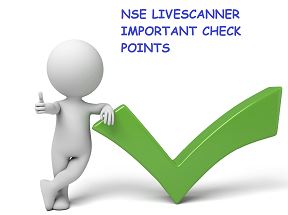Important checklist to start your trading day like a professional
NSE Live Scanners Trading Check List:
Preparing for your trading day is a
must for the serious trader. If you know what to expect for the day ahead, you
can make much better trading decisions, avoid surprises and you are less likely
to miss trades. The following 8 points will give you a head-start and allow you
to approach your trading from a completely new perspective. We will also go
over why each point is so critical:
1. Higher time-frame analysis
A short glimpse at the weekly or daily time-frame is a must before you
start your trading day. It helps put everything into perspective; you can get a
feeling for where you are in the overall trend and you see immediately if any
important obstacles or price levels are coming up.
2 Support and
Resistance
In addition to marking important
price levels from the higher time-frames, knowing where to expect intra-daysupport and resistance is important too. Even if you are not using support and
resistance in your actual trading system, it is a very commonly used trading
concept and millions of traders watch support and resistance levels. Knowing
where other traders will get interested in the market is key.
3 Highs and lows
Especially weekly and previous day’s
highs and lows are a must on your charts. Highs and lows are used by breakout,
range-trading and reversal traders and you can often see a good reaction on
highs and lows because it is such a commonly used concept.
4 Moving averages
It pays off to know where price stands in relation to the most famous
moving averages. The 50, 100 and 200 moving averages are even picked up by the
financial media from time to time when price approaches such levels.Further more, knowing if price moves above or below a certain moving
average can tell a lot about the current market state. Even the “market wizard”
Marty Schwartz named moving averages one of his most favourite trading tools
and he uses them as a directional filter.
5 Volatility and
trend-phase
Knowing if you are in a high or low
volatility market environment is essential because it also tells you how to set
your orders. Whereas you have to apply more conservative order placement in low
volatility times, you should set orders further away when volatility is high.
The ATR indicator is a good indicator when it comes to analysing individual
market volatility.
Especially Bollinger Bands are a
great trading tool because they provide a variety of different information. Widening
or shrinking Bollinger Bands tell you if volatility is high or low; and price
position relative to the Bollinger Bands tells you a lot about the trend-phase.
If price has been moving outside the Bollinger Bands for some time, the trend
is strong and a short-lived price spike through the Bands can signal an
upcoming reversal.
6 Volume
Volume tells you a lot about the
current market state. You have to ask yourself the following two questions when
looking at current volume and price action:
Is price rising on high or low volume?
Rising prices and rising volume
can signal accumulation
Volume above the average is called heavy accumulation
or distribution
in the case of a sell-off
You don’t have to get too lost in the
volume analysis and understanding whether volume is support or going against
current market direction is enough for your market preparation. Applying a
moving average on your volume can help you identify high and low volume market
environments.
7 News for the day
Each morning looks at the economic calendar for the day. Important
upcoming news typically slow down the market prior to the news announcement.
Avoiding trades in pre-news market environments is often a good choice. When
volume is low during such periods, markets can often get erratic and it is
common to see short-lived price spikes.
The two sources that will cover the news for the day are the economic times,
money control and economic calendar.
8 Your last 5
trades
This is among the most important
points to get yourself into the right mindset before you start your trading
day. Knowing if you are currently in a losing or winning streak can help you
avoid risk management mistakes; increasing risk during losing streaks, being
too scared after few losses and getting reckless and too confident after several
wins rank very high on the most commonly made trading mistakes.
Always take a brief look at your trade log to get a feeling for your
past performance.
The checklist
In most high-performance activities,
the top participants work with a checklist. A checklist not only holds you
accountable, but it also makes you more aware of your overall approach. It also
takes out the guesswork and provides a framework which will help you establish
a better and more professional trading routine.




Nice suggestion
ReplyDeleteThanking you
Delete